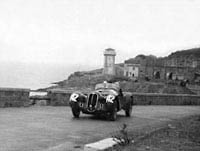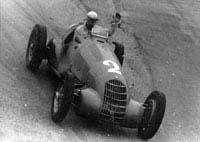By Estanislao Iacona & Cristián Bertschi
Photos courtesy of the Carlo Pintacuda Collection
The 1938 Mille Miglia and Beyond


Driving the magnificent 8C2900B, Pintacuda races against time after brake problems slowed his progress in the 1938 Mille
Miglia. The car, S/N 412030, was later owned for many years by the Bill Serri.
|
The start of 1938 season was not very encouraging for Carlo Pintacuda. For the Mille Miglia, Alfa had entered their latest version of the 8C2900B with a Touring body, one of the greatest Alfa Romeos ever made. Driving one of the four 2900Bs, S/N 412030, Pintacuda was leading at Rome, ahead of Biondetti in the other Touring 2900B. At Terni, Pintacuda had to stop for 40 minutes due to brake problems in his Alfa. Once they were repaired, he started a great drive, placing second behind his old friend Biondetti, losing by only two minutes after a twelve-hour race. He tried to overtake him many times but without success. Carlo felt he was betrayed. After the race, he went to Firenze without going to the award ceremony. Biondetti won his first Mille Miglia but lost his friend.
The Grand Prix of Rio on June 12th was the next challenge. Alfa Corse, still headed by Enzo Ferrari, sent Pintacuda and Tadini with of the new powerful 3-liter 308 C Grand Prix cars. Pintacuda said the new Alfa was "a lovely car, powerful, modern and perfect for the twisty circuit of Gavea". He was very confident for the race, but it was not as easy as he thought. At the start, Pintacuda, unfamiliar with the new Alfa, was passed by many cars in the field, including the Argentinean driver Carlos Arzani. But Gavea was his second home, and by half distance, he had re-passed 28 cars, and was 25 seconds behind the Arzani, who was driving an Alfa Romeo 8C 35 (#50014). Suddenly a heavy rain started to fall on Gavea. Arzani was on worn tires, which made his driving very difficult, and he could not keep the lead. Pintacuda, who thrived in the rain, won the Devil's Springboard for the second time in a row.
Back in Europe, on July 9th and 10th, a new challenge was waiting for him--the Spa-Francorchamps 24 hours. Alfa Corse set two 2.9 Mille Miglia cars for the event, one for Sommer and Biondetti and a second for Pintacuda and Francesco Severi. Again, Pintacuda demonstrated his wet weather skills, winning at an average speed of 76.44 mph for the 24 hours.
Despite his impressive victories, it seemed that Pintacuda was being ignored by the Alfa Corse team. The new 158 voiturette, with a blown 8-cylinder 1.5 liter designed by Giocchino Colombo, was making it's debut, but in the hands of newcomers Severi, Emilio Villoresi, and Raymond Sommer. The 308Cs were entrusted to Farina, Wimille and Pintacuda's old friend Biondetti.
In 1939, the Mille Miglia was canceled after an accident in the 1938 race had left ten people dead. Instead, a 1000-mile race was held in Libya, between Tobruk and Tripoli. Driving one of the new 6C2500SS models, Pintacuda place third, behind Biondetti in second, and Mussolini's chauffeur, Ercole Boratto, who won the race. Pintacuda got his first drive with the new Alfetta at Tripoli, but Mercedes appeared with the W165 and thoroughly trounced the field. Next were the Coppa Ciano and the Coppa Acerbo, both in Italy. Pintacuda drove the Alfetta 158 to second at the Coppa Acerbo and third at the Coppa Ciano.


Pintacuda was also victorious behind the wheel of Alfa's Grand Prix cars. Here he is seen
winning the VI Grande Prêmio do Rio de Janeiro, June 12, 1938, with the Alfa 308.
|
In September of 1939, World War II began and only the Italians and Americans held races in 1940. On April 28th, a modified version of the Mille Miglia was staged, this time with engine limitations. Alfa sent a team of four 6C2500SS, three spyders and one coupe for Count Trossi. But the Alfas were down on power compared to the new BMWs, which won the race. Pintacuda managed a seventh place, in this, his last Mille Miglia. At Tripoli, again with the 158, he finished fourth, with engine trouble, behind Farina, Biondetti and Trossi, all with Alfettas. The Mercedes Team did not appear, as the Germans thought that the English navy would confiscate their new 1.5-liter cars during the trip.
Post-War Life
After the years of the conflict, Pintacuda went to Alfa to ask to drive an Alfetta at an event in Brazil After a spoken agreement and only 15 days before starting the trip, Alfa Romeo canceled the loan.
A solution seemed to turn up when Enrico Platé offered him a prewar 1.5 liter Maserati, but during the trip to South America, Carlo had a liver attack, and once in Rio he could not start the race.
He recovered for the Boa Vista race held on December 15th 1946 but still had pains and high temperature. After the second lap, he stopped and was immediately taken to a hospital.
In the first days of 1947 Carlo went to Buenos Aires, Argentina to race at Retiro, the first race of "La Temporada Argentina". The old Maserati only lasted a couple of laps and Carlo made two important decisions. The first one was to quit racing, and the second was to stay in Buenos Aires.
However, he could not resist the temptation to race and came back to Gavea in 1948 with Jean Pierre Wimille and his Simca-Gordini, but he had to retire just two laps after the start. This was his very last race.
An Incredible Character
With a white driving suit and jacket at the races, or a black suit in his everyday life, Carlo Pintacuda had a great sense of humour. He decided to live in Buenos Aires in 1947 when he swapped passions, motor racing for antiquities, and opened a shop called La Spiga. But he could never say no to a question regarding cars; just a word about racing and he would begin to start talking about the old days.
He was born in 1900 and passed away silently, in 1971. Undoubtedly, Alfa Romeo owes a great deal to Carlo Pintacuda, who represented the Portello pride every time he was behind the wheel of an Alfa.
Our thanks to Argentinean correspondents Cris Bertschi and Lao Iacona for this unique biography of Carlo Pintacuda.
. . . . . . .
Part I- A Pre-War Hero Part I
Part II- The Scuderia days



